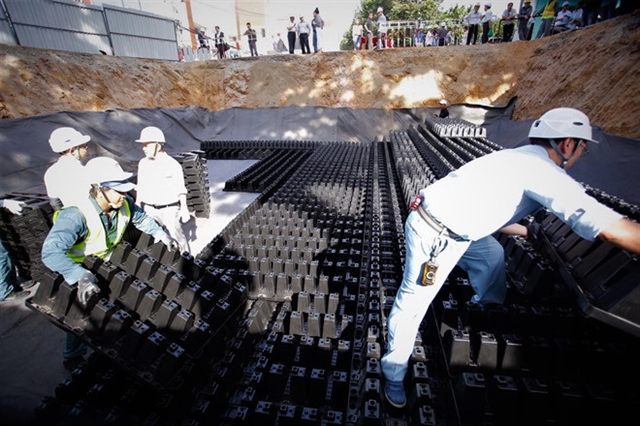 Society
Society

HCM City plans to spend hundreds of billions of đồng on building more than 100 reservoirs to store rainwater and control flooding by 2020 under a flood-control programme.

|
| A reservoir on Hoàng Văn Thụ Street in HCM City’s Tân Bình District.— VNS File Photo. |
HCM CITY — HCM City plans to spend hundreds of billions of đồng on building more than 100 reservoirs to store rainwater and control flooding by 2020 under a flood-control programme.
However, many existing reservoirs are yet to be connected with each other for the flood-control programme.
The reservoirs, which will have pump and culvert systems, will collect rainwater.
The biggest, with a capacity of 20,000cu.m, will be built at the Gò Vấp Flower Village, while the second largest, measuring around 5,000cu.m, will be at Hoàng Văn Thụ Park in Tân Bình District.
The others will be smaller, with a capacity of 1,500-2,000cu.m each.
The Tân Bình District currently has a big reservoir but its water level has never reached its full capacity.
According to an expert from the HCM City Urban Drainage Co. Ltd., the Hoàng Văn Thụ Reservoir has a capacity of more than 35,000cu.m of water.
Experts from the HCM City Urban Drainage Co. Ltd. suggested that the reservoir should be connected with the city’s sullage pits so that rainwater could be drained into the reservoir to reduce flooding, but the proposal was shot down.
The Hoàng Văn Thụ Reservoir has yet to be used to regulate rainwater and combat flooding around Tân Sơn Nhất International Airport, an expert said.
Many other reservoirs in inner districts too are not connected with the reservoir network for flood control, including those at Lê Thị Riêng Park in District 10, Đầm Sen Tourism Park in District 11, Phú Lâm Park in District 6, Văn Thánh in Bình Thạnh District, Song Tân and Hương Tràm in District 7, and Kỳ Hoà in District 10.
According to figures from the HCM City Urban Drainage Co. Ltd., Hoàng Văn Thụ and Văn Thánh reservoirs have a combined capacity of over 40,000cu.m, while Kỳ Hoà has can hold over 6,400cu.m of water.
Reservoirs to beautify city
Experts from the HCM City Urban Drainage Co. Ltd. said these reservoirs could help prevent flooding but have not been connected with the drainage network or used for flood prevention.
The managers of many of the reservoirs do not allow them to be connected with drainage networks in inner districts because the drains carry both rainwater and wastewater, which could pollute them.
They said the reservoirs were built to enhance the city’s looks rather than for regulating rainwater or controlling floods.
Wastewater treatment and separating rainwater from wastewater is the job of other agencies, they added. — VNS